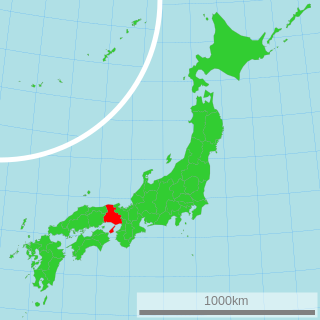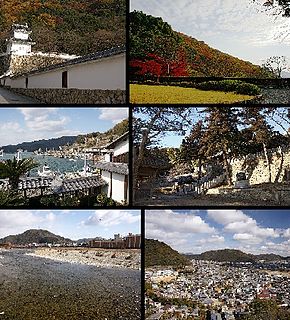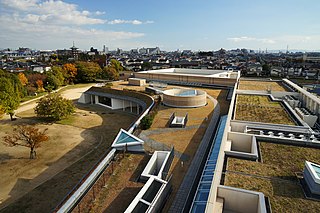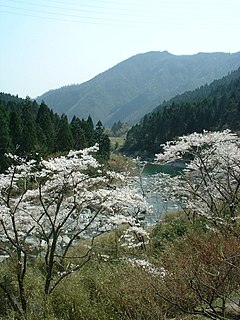
Hyōgo Prefecture is a prefecture of Japan located in the Kansai region of Honshu. Hyōgo Prefecture has a population of 5,469,762 and has a geographic area of 8,400 square kilometres (3,200 sq mi). Hyōgo Prefecture borders Kyoto Prefecture to the east, Osaka Prefecture to the southeast, and Okayama Prefecture and Tottori Prefecture to the west.

Nagahama is a city located in Shiga Prefecture, Japan. As of 1 November 2021, the city had an estimated population of 116,043 in 46858 households and a population density of 120 persons per km². The total area of the city is 680.79 square kilometres (262.85 sq mi).

Tatsuno is a city in Hyōgo Prefecture, Japan. The city was founded on April 1, 1951.

Tajima Province was an old province of Japan in the area that is today northern Hyōgo Prefecture. It was sometimes called Tanshū (但州). Tajima bordered on Harima, Inaba, Tanba, and Tango provinces.

Harima Province or Banshū (播州) was a province of Japan in the part of Honshū that is the southwestern part of present-day Hyōgo Prefecture. Harima bordered on Tajima, Tanba, Settsu, Bizen, and Mimasaka Provinces. Its capital was Himeji.

Harima is a town located in Kako District, Hyōgo Prefecture, Japan. The town shares its name with Harima Province, one of the old provinces of Japan. Harima was known as Ae village until April 1962. The name "Harima" is derived from a large area in southwestern Hyōgo Prefecture, commonly referred to as "the country of Harima," or Banshū area.
Ibogawa was a town located in Ibo District, Hyōgo Prefecture, Japan.

Taishi is a town located in Ibo District, Hyōgo Prefecture, Japan.

Ibo is a district located in Hyōgo Prefecture, Japan.

A washitsu (和室), meaning "Japanese-style room(s)", and frequently called a "tatami room" in English, is a Japanese room with traditional tatami flooring. Washitsu also usually have sliding doors, rather than hinged doors between rooms. They may have shōji and, if the particular room is meant to serve as a reception room for guests, it may have a tokonoma.

Asago is a city located in northern Hyōgo Prefecture, Japan. The modern city of Asago was established on April 1, 2005, from the merger of the former town of Asago absorbing the towns of Ikuno, Santō and Wadayama.

Hikimi Wasabi (匹見ワサビ) is a variety of wasabi cultivated in Hikimi Town, Shimane Prefecture, Japan.
The Banshū dialect, also called the Harima dialect, is a Japanese dialect spoken in the Harima region of southwestern Hyōgo Prefecture. Although it is included in the Kansai dialect group, it shares much of its vocabulary with Chūgoku group. It can be further subdivided into the Western Banshū dialect and the Eastern Banshū dialect.

The Rakuraku Harima (らくラクはりま) is a Commuter Limited Express train operated by West Japan Railway Company between Osaka Station and Himeji Station, on the JR Kobe Line.
Harima Science Garden City(播磨科学公園都市, Harima-Kagaku-Koen-Toshi) is a city constructed by opening up a hilly area in Harima, the southern-west part of Hyogo Prefecture. The city straddles Tatsuno, Kamigori and Sayo. The address was named Koto, which means city of light. In the north part of the city are SPring-8 and SACLA. It is a base-city of the Nishi-Harima Technopolis Plan.
Yoshikatsu Takeiri is a Japanese politician who served as the third chair of Komeito from 1967 to 1986, making him the longest serving leader in the party's history.

Harima Sea is the eastern part of the Seto Inland Sea in Japan. Located on the south side of the southwestern part of Hyogo Prefecture, it is bounded by Awaji Island to the east, Shodoshima to the west, and Shikoku in the south, with the Ieshima Islands in the northwest.

The 1938 Hanshin flood was caused by heavy rains, which resulted in landslides and floods in the Mount Rokkō area, Hyōgo Prefecture in Japan in July 1938. According to the official government report, torrential rains resulted in flash floods and debris flows that affected the Mount Rokko area, including Kobe and Nishinomiya. At least 715 people lost their lives.

The Ichi River is a river which flows through the southwest of Hyōgo Prefecture, Japan. The Ibo, Kako, Ichi, Yumesaki, and Chikusa rivers are collectively referred to as the Harima Gokawa, the five major rivers that flow into the Harima Sea.















